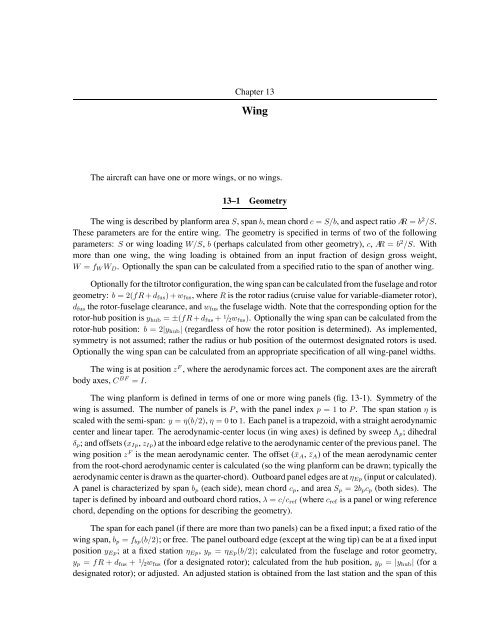Download - NASA
Download - NASA
Download - NASA
You also want an ePaper? Increase the reach of your titles
YUMPU automatically turns print PDFs into web optimized ePapers that Google loves.
Chapter 13<br />
Wing<br />
The aircraft can have one or more wings, or no wings.<br />
13–1 Geometry<br />
The wing is described by planform area S, span b, mean chord c = S/b, and aspect ratio AR = b 2 /S.<br />
These parameters are for the entire wing. The geometry is specified in terms of two of the following<br />
parameters: S or wing loading W/S, b (perhaps calculated from other geometry), c, AR = b 2 /S. With<br />
more than one wing, the wing loading is obtained from an input fraction of design gross weight,<br />
W = fW WD. Optionally the span can be calculated from a specified ratio to the span of another wing.<br />
Optionally for the tiltrotor configuration, the wing span can be calculated from the fuselage and rotor<br />
geometry: b =2(fR+ dfus)+wfus, where R is the rotor radius (cruise value for variable-diameter rotor),<br />
dfus the rotor-fuselage clearance, and wfus the fuselage width. Note that the corresponding option for the<br />
rotor-hub position is yhub = ±(fR+ dfus + 1/2wfus). Optionally the wing span can be calculated from the<br />
rotor-hub position: b =2|yhub| (regardless of how the rotor position is determined). As implemented,<br />
symmetry is not assumed; rather the radius or hub position of the outermost designated rotors is used.<br />
Optionally the wing span can be calculated from an appropriate specification of all wing-panel widths.<br />
The wing is at position z F , where the aerodynamic forces act. The component axes are the aircraft<br />
body axes, C BF = I.<br />
The wing planform is defined in terms of one or more wing panels (fig. 13-1). Symmetry of the<br />
wing is assumed. The number of panels is P , with the panel index p =1to P . The span station η is<br />
scaled with the semi-span: y = η(b/2), η =0to 1. Each panel is a trapezoid, with a straight aerodynamic<br />
center and linear taper. The aerodynamic-center locus (in wing axes) is defined by sweep Λp; dihedral<br />
δp; and offsets (xIp, zIp) at the inboard edge relative to the aerodynamic center of the previous panel. The<br />
wing position z F is the mean aerodynamic center. The offset (¯xA, ¯zA) of the mean aerodynamic center<br />
from the root-chord aerodynamic center is calculated (so the wing planform can be drawn; typically the<br />
aerodynamic center is drawn as the quarter-chord). Outboard panel edges are at ηEp (input or calculated).<br />
A panel is characterized by span bp (each side), mean chord cp, and area Sp =2bpcp (both sides). The<br />
taper is defined by inboard and outboard chord ratios, λ = c/cref (where cref is a panel or wing reference<br />
chord, depending on the options for describing the geometry).<br />
The span for each panel (if there are more than two panels) can be a fixed input; a fixed ratio of the<br />
wing span, bp = fbp(b/2); or free. The panel outboard edge (except at the wing tip) can be at a fixed input<br />
position yEp; atafixed station ηEp, yp = ηEp(b/2); calculated from the fuselage and rotor geometry,<br />
yp = fR + dfus + 1/2wfus (for a designated rotor); calculated from the hub position, yp = |yhub| (for a<br />
designated rotor); or adjusted. An adjusted station is obtained from the last station and the span of this
















